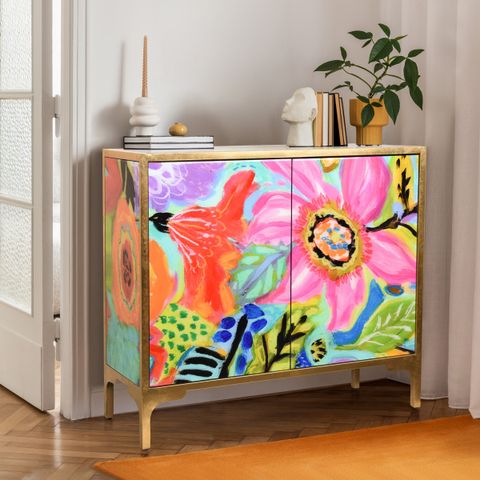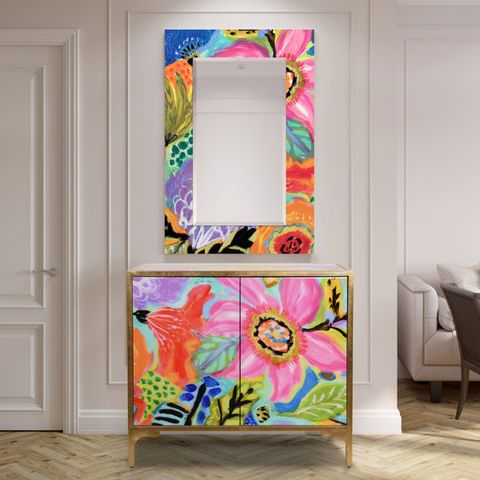Picture this: a stunning floral cabinet standing proudly in a living room, its glass panels catching and dancing light in ways that seem almost magical. What makes this possible? The answer lies in the ancient art of beveled glass craftsmanship, a technique that has been perfected over centuries. This isn’t just about pretty windows – it’s about creating something that transforms ordinary spaces into extraordinary experiences.
Floral cabinets have always been more than mere storage solutions. They’re statements of taste, vessels for beauty, and silent conversations about the owner’s aesthetic sensibilities. But what truly elevates these pieces from functional furniture to artistic masterpieces? It’s often the subtle interplay between light and glass, particularly when that glass features the skilled craftsmanship of beveled art. These intricate glass elements don’t just catch light – they sculpt it, refract it, and transform it into something ethereal. The marriage of traditional glassblowing techniques with modern design sensibilities creates cabinets that feel both timeless and contemporary. Whether you’re a collector, designer, or simply someone who appreciates beautiful things, understanding the craftsmanship behind these beveled marvels adds a new layer of appreciation to their presence in any space.
What Makes Beveled Glass Special
Beveled glass is far from ordinary. While regular glass simply blocks or transmits light, beveled glass takes that interaction and turns it into a performance. The edges of the glass are cut at precise angles, creating facets that bend and redirect light in fascinating ways. Imagine standing in a room where every angle of light seems to have a personality of its own – that’s the magic of beveled glass in action.
The process starts with selecting the right type of glass. Different thicknesses, clarity levels, and even slight variations in composition can dramatically affect how the final product will behave. Then comes the cutting phase – not just any cutting, but careful, methodical work using specialized tools that can create angles ranging from subtle 15-degree cuts to dramatic 45-degree facets. The precision required here is remarkable, especially when considering that even a tiny deviation can change the entire character of the finished piece.
What makes this craft truly special is its ability to create depth and dimensionality that flat glass simply cannot match. When light hits a beveled surface, it doesn’t just bounce off – it gets redirected, scattered, and sometimes even split into multiple rays. This creates an almost three-dimensional quality to the glass itself, making it appear to pulse with life. In a floral cabinet, this means that each flower arrangement becomes a focal point not just because of its arrangement, but because the glass surrounding it seems to breathe and move with the light.
Historical Roots and Evolution
The story of beveled glass isn’t just about modern aesthetics – it’s deeply rooted in centuries of craftsmanship and cultural evolution. The earliest examples of beveled glass can be traced back to ancient Egypt and Rome, where artisans discovered that creating angled surfaces could dramatically alter how light interacted with their creations. These early practitioners were essentially experimenting with what we now understand as optical physics, albeit without the scientific terminology.
During the Victorian era, beveled glass experienced a renaissance. The period’s love of ornate decoration and elaborate craftsmanship created the perfect environment for glass artists to push boundaries. The Industrial Revolution brought new tools and techniques, but it was the human touch that remained essential. Master craftsmen would spend months perfecting a single panel, ensuring that each bevel was precisely aligned with the others.
The evolution didn’t stop there. As we moved into the 20th century, designers began experimenting with different materials and techniques. Some artists started incorporating colored glass into their beveled work, creating pieces that were not just visually striking but emotionally resonant. Today, the tradition continues with modern artists combining traditional methods with contemporary design philosophies, resulting in cabinets that honor the past while embracing the future.
Design Considerations for Floral Cabinets
When incorporating beveled glass into floral cabinet design, several key factors must align for success. First and foremost is the overall style of the room. A Victorian-style cabinet might call for heavy, ornate beveling that emphasizes the historical nature of the piece. Meanwhile, a modern minimalist space might benefit from clean, geometric bevels that provide definition without overwhelming the senses.
Consider the lighting situation carefully. Natural light changes throughout the day, casting different shadows and highlighting different aspects of the beveled glass. Artificial lighting adds another layer of complexity, as different bulb types and placements can dramatically alter the appearance of the same glass panel. The goal is to create a design that remains beautiful regardless of the light conditions.
The size and placement of beveled panels also matter significantly. Large panels can serve as dramatic focal points, while smaller sections might create a more subtle background element. Some designers choose to frame entire cabinet doors with beveled edges, while others use them sparingly to highlight specific areas. The key is to ensure that the beveled elements support rather than compete with the floral arrangements inside.
Color coordination plays a crucial role too. Clear beveled glass allows maximum light transmission, creating an airy, open feeling. Frosted or tinted versions can add privacy while still maintaining the visual interest of the bevels. Colored beveled glass introduces another dimension entirely, potentially creating a rainbow effect when light passes through multiple panels.
Craftsmanship Techniques and Tools
Creating quality beveled glass requires more than just skill – it demands specific tools and techniques that have been refined over generations. The basic process begins with selecting raw glass sheets, which must meet strict standards for clarity and uniformity. Even the slightest imperfection can become magnified when the glass is cut and polished.
The cutting process itself is both an art and a science. Traditional methods involve using diamond-tipped wheels or specialized saws to create precise angles. Modern techniques often incorporate laser technology for extreme precision, though many artisans still prefer the tactile feedback and control of manual tools. The angle of the cut determines not just the visual appearance but also the structural integrity of the finished piece.
Once the bevels are cut, the real work begins. Polishing involves multiple stages using progressively finer abrasives. This step is critical because any rough spots will scatter light poorly and detract from the overall effect. Some craftsmen use hand-polishing techniques passed down through generations, while others combine traditional methods with modern machinery for efficiency.
Quality control during production is essential. Each piece must be tested under various lighting conditions to ensure it performs as expected. This testing phase can take hours for complex designs, but it’s necessary to guarantee that the final product meets the high standards expected in premium furniture.
Maintenance and Care Guidelines
Like any fine art, beveled glass requires proper care to maintain its beauty and functionality over time. The good news is that with the right approach, these pieces can last for decades while maintaining their visual impact. Regular cleaning with appropriate products is fundamental. Harsh chemicals or abrasive materials can damage the delicate beveled edges, so it’s important to use gentle, non-abrasive cleaners specifically designed for glass surfaces.
Dusting should be done regularly using soft cloths or microfiber materials. These fabrics won’t scratch the glass or leave behind lint. For deeper cleaning, a mixture of mild soap and water works well, followed by thorough drying with a clean cloth. Some craftsmen recommend using specialized glass cleaning solutions that can remove fingerprints and oils without leaving streaks.
Environmental factors also play a role in preserving beveled glass. Direct sunlight can cause fading in some colored glasses, while extreme temperature changes can stress the glass and potentially lead to cracking. Keeping the cabinet away from direct heat sources and maintaining consistent humidity levels helps preserve both the glass and the wooden cabinet structure.
Storage considerations are also important. If you need to move a floral cabinet, proper packing and handling are essential. The beveled panels should be wrapped carefully, and the cabinet should be moved upright whenever possible to avoid putting pressure on the glass elements.
Choosing Quality Beveled Glass
Not all beveled glass is created equal, and understanding the differences can help you make informed decisions when selecting materials for your floral cabinet projects. The first consideration is the quality of the base glass. Higher-grade glass typically has fewer impurities and better optical clarity, which translates directly into how well the beveled surfaces perform. Look for glass that appears uniformly clear without visible bubbles or distortions.
The craftsmanship of the beveling itself is equally important. Well-executed bevels should be consistent in width and angle. Uneven bevels can create an unbalanced appearance and poor light distribution. Check that the edges are smooth and free from chips or rough spots. These imperfections not only affect the visual appeal but can also be dangerous if someone accidentally touches them.
Consider the supplier’s reputation and experience. Established glass manufacturers and artisans who specialize in furniture applications typically offer better quality control and customer service. They should be able to provide samples and detailed information about their processes and materials. Don’t hesitate to ask about warranties or guarantees on their work.
Price is another factor to consider, but remember that cheap options may end up costing more in the long run due to replacement needs or poor performance. Investing in quality beveled glass pays dividends in both visual satisfaction and longevity. Sometimes, the extra cost is justified by the superior light manipulation and overall aesthetic impact.
The craftsmanship behind beveled art glass in floral cabinet designs represents a beautiful intersection of history, artistry, and function. These pieces don’t just hold flowers – they hold light, emotion, and the accumulated wisdom of countless artisans who have perfected their craft over generations. Every beveled edge tells a story of precision and dedication, every facet a testament to the power of careful attention to detail. Whether you’re designing a new piece, restoring an antique, or simply admiring the beauty of existing work, understanding this craftsmanship adds a new appreciation for the subtle magic that happens when light meets glass. The true value of beveled art glass lies not just in its visual appeal, but in its ability to transform ordinary moments into something that feels almost sacred. After all, what could be more beautiful than watching light dance across perfectly crafted glass surfaces while surrounded by the natural beauty of fresh flowers?














